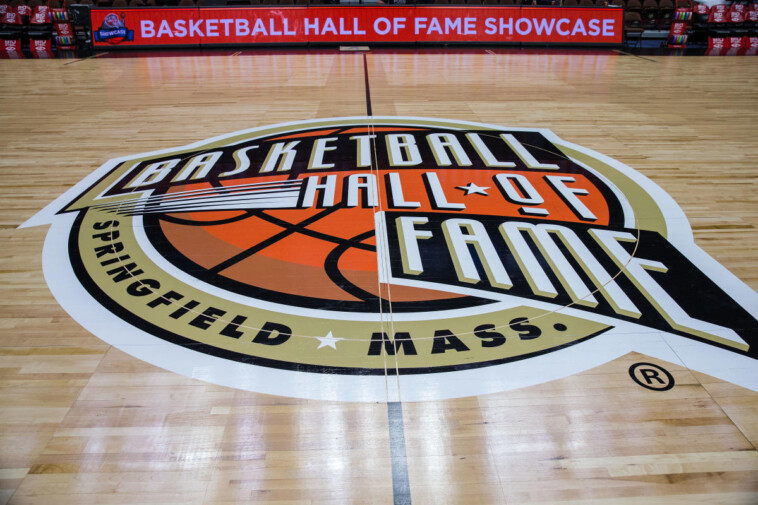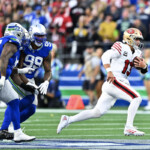The NBA does pageantry better than anyone and that extends to the Naismith Memorial Basketball Hall of Fame — with induction night on Sunday sure to be filled with viral moments, laughter and tears. Vince Carter, Chauncey Billups, the late Walter Davis and Michael Cooper are the headliners in this year’s class — along with the recently passed Jerry West being honored in the contributors category.
But does anyone know exactly how the inductees are selected, and who does it?
It’s too important of an event to be covered under the shroud of secrecy, and it’s an important event because of the work the NBA has done in revitalizing it — headed by Naismith Memorial Basketball Hall of Fame chairman Jerry Colangelo, whose basketball resume is never-ending. You feel like you’re walking into a basketball shrine in Springfield, Massachusetts, from all the shoes, basketballs and jerseys of the greats to exhibits on the evolution of the rims themselves.
The Hall has gotten that part right because the NBA wanted it to, and the league knew that compared to other professional sports, it lagged behind in making the weekend as glorious as it could be.
But when you look at the classes in the Hall, there are some inconsistencies in the selections — even if most of them are no-brainers. All we know is the media will get an email from the Hall sometime in February announcing the finalists and then before the NCAA Final Four the class will be revealed.
It’s cute and tidy, but the transparency is lacking.
This is a league that listens and reacts, and is very sensitive to the belief that things aren’t as clear-cut as they should be, in full view of the public. Its draft lottery — while done in a room where media and team personnel aren’t allowed to bring phones or video devices inside to ensure integrity — is shown to all in the moment. The media can actually touch the pingpong balls and feel they don’t weigh differently than the others, and anyone there can touch the actual machine the pingpong balls are launched into, so we can see there’s no funny business.
It has turned into a made-for-TV moment during the conference finals, a half-hour long show where the fortunate few are sequestered, unable to communicate with the outside world while watching the process of big envelopes with team logos being unveiled.
It’s nerve-wracking and annoying, but it is fun in a way, and while one supposes anything can happen to gerrymander a certain result, we at least feel like the league is doing its part in indulging the conspiracy theorists and showing everything is at the line.
The NBA’s season awards process, while turning into a bit of X groupthink, lets every voter know their selections will be made public once every award is revealed. There’s accountability for the voter, and while it can lead to influences trying to tilt the scales, it’s usually a process that feels quite genuine.
Random MVP votes have been few and far between in the decade since the NBA implemented this policy, and although there’s an argument against it, it’s done more good than harm.
And even from a historical perspective, the NBA told the world exactly who was part of the voting committee for its top 75 (actually 76) player list for its 75th anniversary — again, a moment filled with all the pageantry the NBA wants to bathe in, most of the top 76 being in a room together reminiscing and connecting in ways that will be chronicled forever.
That committee was filled with basketball royalty, and even if you want to question the qualifications of some of the voters, the NBA got it right, by and large.
But that process has not extended to the place where basketball figures will be forever immortalized, the Naismith Memorial Basketball Hall of Fame.
Baseball voters will tell you exactly whom they voted for, tell you why Barry Bonds isn’t in and stand on it. We can see who reaches the 75 percent threshold, how close some are to finally getting in while others are far, far away from it.
In football, it feels even more intimate. The writers get in a room and openly discuss and make cases for candidates to get in. Now that may feel a bit squirmy because of the media-player relationship often being cast as antagonistic, but when it comes to pure athletic excellence, those petty grievances, if they exist, can be put away for the case of merit. In this instance, it could be a TV moment, but for sake of the process, we only imagine how these discussions go.
None of this happens in basketball, and it’s frustrating. Is it merely a popularity contest? What’s the criteria? Who’s in the room? Hell, is there a room? According to a 2022 report from ESPN, the final ballots are destroyed.
Now, this is not to pick on Michael Cooper, an integral player for the Showtime Lakers in their five NBA championships during the NBA’s greatest period of on-floor growth and off-floor popularity, but in what world is he a sure-fire Hall of Famer?
He wasn’t a starter, playing behind Norm Nixon and then Byron Scott, averaged double figures only twice in his career, and never made an All-Star team. Now, offense is one half of the floor and the NBA has come to devalue defense, so it is refreshing in a way to see Cooper honored, as he was a Defensive Player of the Year and an eight-time member of the All-Defensive Team.
But did we look at Cooper, while he was playing, and say, “That’s a Hall of Famer?” If someone did, please raise your hand and come to the front of the room.
When thinking of the Showtime Lakers, one thinks of Magic Johnson, then Kareem Abdul-Jabbar, then perhaps James Worthy — and maybe Bob McAdoo, Jamaal Wilkes and a few others.
If you have to squint and look at a player long and hard, is he truly a Hall of Famer or just someone of note, someone you had to deal with?
There’s supposed to be an exclusivity that comes with being in the Hall. Unfortunately, some good players who left a mark on the game should be left on the outside looking in — that shows how special it is, how hard it is to get in.
It’s easier to get into the Hall than it is to make an All-Star team, it seems, and without the transparency, we have no way to know how much weight is given to Cooper’s coaching career in the WNBA compared to his on-floor career that ended in 1990, or if we as a collective basketball community have changed our minds on how important some players are relative to conventional thinking of the past.
Perhaps that’s the case. And if it is, it should be explained rather than leaving the public to assume why a player gets in — because there’s certainly a few others who’ve had great cases, but we never hear them discussed even tangentially, and that feels like a disservice.
There isn’t some baseline set of rules that determine a Hall of Famer. It’s in the eyes of the fans and media. Some crowed when Tracy McGrady got in, a scoring champion who never seemed to fulfill his massive potential — some of it from bad luck. Actually most of it was bad luck.
Same went for Ben Wallace, another one-way player who’s style defined a generation with his record four Defensive Player of the Year awards. There’s not much argument from here on those guys, but it’s understandable if those with higher standards had questions that needed answering, if the Hall is supposed to be extremely difficult to get into.
Billups was a catalyst for a good team turning into a great one in Detroit, winning a Finals MVP in 2004, and helping the Denver Nuggets to their best stretch of success before the recent run buoyed by Nikola Jokić. Basketball-Reference.com has him listed as an 84.4 percent probable Hall of Famer, higher than recent inductee Tim Hardaway, higher than Joe Dumars (2006 inductee) and Dennis Rodman.
Carter’s Basketball-Reference probability is even higher, at 94.5 percent — higher than Kawhi Leonard, Tony Parker and James Worthy. Carter didn’t have the singular playoff success, but he carried franchises and was a premier face for a decade — with his play warranting every bit of attention. He wasn’t just a highlight film, he was a superstar player.
And again, if McGrady is a model, Carter compares favorably, even before he began his run as a trusted vet off the bench or a spot starter. And that’s not factoring in his stellar career at the University of North Carolina.
Cooper’s probability? 0.9 percent.
The Basketball-Reference model isn’t a perfect one, and context is needed beyond the numbers, so he has more of a case. But a Hall case, an unassailable one?
This isn’t calling for the NBA to separate itself from the Naismith Memorial Basketball Hall of Fame. It’s a great event that tells stories about integral figures at all levels — from internationally, to the women’s side, to the contributors and coaches who’ve helped shape this wonderful game.
It would just feel a little better if we knew who was making the selections, why the selections were made and the arguments for them.
The players deserve that, and the Hall itself deserves it.



